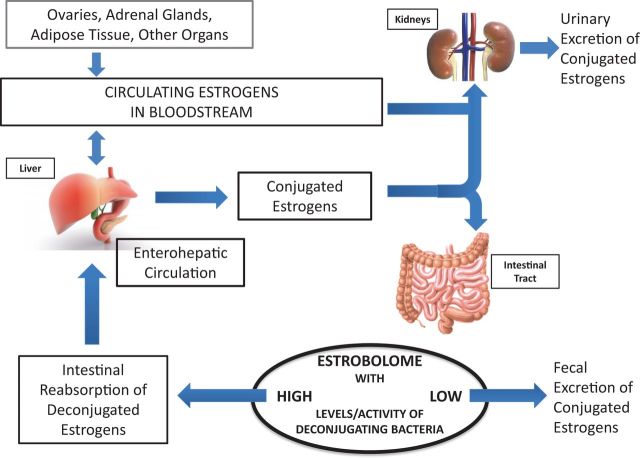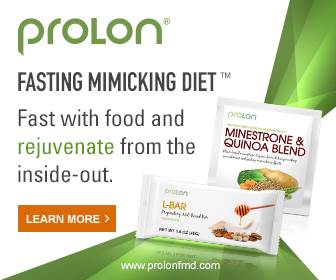Did you know the microbes in your gut influence your hormones? That’s right: the bugs in your colon can increase your risk for diabetes, obesity, heart disease, hormone imbalance, and even hormone-related cancers and conditions like PCOS and endometriosis.
Your gut is home to trillions of bacteria, viruses, archaea, and eukaryotes, collectively known as your microbiome. We’re learning more and more about the gut microbiome, and we know the gut influences the health of all your body systems.
The estrobolome in particular is a collection of bacteria, a little microbiome within your gut biome, that regulates and metabolizes circulating estrogen, one of your main sex hormones (even if you are a dude). This estrobolome influences estrogen metabolism and hormone balance, including managing your risk of developing estrogen-related diseases such as endometriosis, breast cancer, and prostate cancer.
If your gut microbes are out of balance (dysbiosis), estrogen levels in the body may be adversely affected. Nagging symptoms like PMS and heavy periods can turn into more serious hormone imbalance and eventually disease. So, it’s important to understand how to support healthy gut function so that your estrobolome will positively influence your estrogen balance.
What is Estrogen?
Both men and women have estrogen, one of your main sex hormones. Women need estrogen for fertility and to regulate the menstrual cycle. In men, estrogen is involved in sperm production and libido.
Women have three different types of estrogen:
- Estradiol is a woman’s “main” estrogen in her fertile years. Estradiol is important for maintaining female reproductive tissues, supporting bone growth, and influencing heart health and memory. This form of estrogen is thought to play a role in diseases such as endometriosis, fibroids, and cancers of the uterus, ovaries and breasts.
- Estrone is the weakest estrogen that’s the most active after menopause.
- Estriol levels rise throughout pregnancy and peak right before childbirth. Estriol helps prepare the body for labor and delivery.
Estrogen is a bit of a goldilocks hormone: you don’t want too much or too little. You want estrogen to be just right. If you have too much estrogen, you’re estrogen dominant, and that causes irregular periods, sore and lumpy boobs, bloating, weight gain, PMS, mood swings, and puts you at risk for breast cancer. In men, higher estrogen levels cause fibrocystic breasts and gynecomastia.
In women, the majority of estrogen is produced by the ovaries and to a lesser extent, the adrenal glands. In men, the testes produce estrogen. But we now know the estrobolome can affect the way estrogen is metabolized in your body and can alter your estrogen levels. (source)
How The Estrobolome Influences Your Hormones
Microbes in the estrobolome produce an enzyme (beta-glucuronidase) that influences estrogen metabolism. In a perfect world, circulating estrogen does its job in the body and is then metabolized by your liver and prepared for excretion in bile, urine, and poop. But if you have too many of the particular bacterial species in the gut that produce beta-glucuronidase, this estrogen that should be removed is deconjugated (by the bacterial species with beta-glucuronidase activity), leading to its reabsorption into circulation. (source)
This all means if you have too many bad bacteria in your gut, beta-glucaronidase activity is altered, and that can cause more estrogen to remain in the body instead of being properly excreted via pooping (that’s why it is SO important for hormone balance to poop every day!!). The stool test I recommend, the GI MAP, has a marker to let you know your beta-glucuronidase levels so you know if you’re not detoxing estrogen properly. Remember, you do NOT want too much estrogen circulating because it affects your overall hormone balance and puts you at risk for breast and hormonal cancers.
Estrobolome disruption in postmenopausal women is associated with an increased risk of obesity, cardiovascular disease, and loss of bone density such as osteoporosis. (source)
The estrobolome is influenced by diet, genetics, alcohol intake, and your environment, which contains xenoestrogens (chemicals that act like estrogen in the body). Xenoestrogens are found in pollutants and common household products such as fragrances, pesticides, and plastics. These bad synthetic estrogens are absorbed by the body and stored in the liver and fat cells. They can act additively with endogenously produced estrogens, influence cell proliferation, and otherwise negatively disrupt the hormonal balance of the body.
Three Steps to Balance Your Estrobolome
Anything that disrupts the microbiome will also disrupt the estrobolome. Alcohol, diet, medications (like antibiotics and birth control pills), and chronic stress exert negative effects on your estrobolome.
Here are three steps to balance your estrobolome.
First things first: Diet strongly influences the estrobolome. Eat a gut-friendly diet with plenty of fiber and prebiotic foods to help bind up excess estrogens so you can poop them out. Tap here for my microbiome friendly diet. Here are a few superstars to include:
- cruciferous vegetables which help detox estrogens thanks to a compound called indole-3-carbinole
- legumes. These gut superstars pack the fiber and boost specific strains of bacteria that produce short chain fatty acids. Chick peas especially seem to boost facealabacteirum prausnitzii which produces butyrate, a short chain fatty acid that feeds colon cells.
- avocados: good fats + good fiber
- prebiotic fibers like banana, alliums, asparagus, artichoke
- pomegranate is a gut superfood.
- lacto-fermented foods like raw kraut. Lacto fermentation boosts Lactobacillus acidophilus which helps decrease bacteria that produce beta-glucuronidase.
- phyto-estrogen rich foods like flax, lentils, and tofu (if you digest it) can help regulate estrogen levels. Lignans are the special type of fiber that estrobolome bacteria convert to phytoestrogens, and flax especially is a good source of lignans. Try ground flax in a smoothie like this one.
Secondly, get rid of dysbiosis. Dysbiosis means you have an imbalance of good to bad bacteria in your gut. It can also mean you have too many of a specific strain of bacteria. There are particular bacteria that produce beta-glucaronidase, and those include certain bacteroides species, clostridium, E. coli, eubacterium, peptostreptococcus, ruminococcus, and staphylococcus. (read more here) Run a GI MAP stool test to see your beta-glucaronidase level and if you have high levels of the aforementioned bacteria. You can order that test here.
Once you get your results, you’ll see exactly where your gut needs work. You will need a gut repair protocol if you have high beta-glucaronidase. You can also add in estrogen detox support like calcium glucarate and diindolylmethane (DIM). Both support estrogen detox and healthy estrogen metabolism.
Thirdly, re-seed the gut by repopulating the beneficial bacterial species. Once you’ve done the work to normalize your gut bacteria, you can use the specific probiotics you need (the GI MAP test will tell you which probiotic strains are low) to repopulate your gut with the good bacteria you need to keep the bad guys in check. Also beef up on your prebiotic foods that help your probiotic colonies flourish. Read this article for more on that.
This process–fixing and re-seeding your gut, improving your diet–also benefits your immune health.
Conclusion
Your gut microbes strongly influence your estrogen levels. High levels of certain bacteria in your gut increase estrogen which puts you at risk for hormonal conditions, cancer, and man boobs and low libido if you are a man. So mind your gut bugs, get your fiber, get some exercise, and reduce your toxic exposure.
Pin it!

Mary Vance is a Certified Nutrition Consultant and author specializing in digestive health. She combines a science-based approach with natural therapies to rebalance the body. In addition to her 1:1 coaching, she offers courses to help you heal your gut and improve your health. Mary lives in San Francisco and Lake Tahoe in Northern California. Read more about her coaching practice here and her background here.








